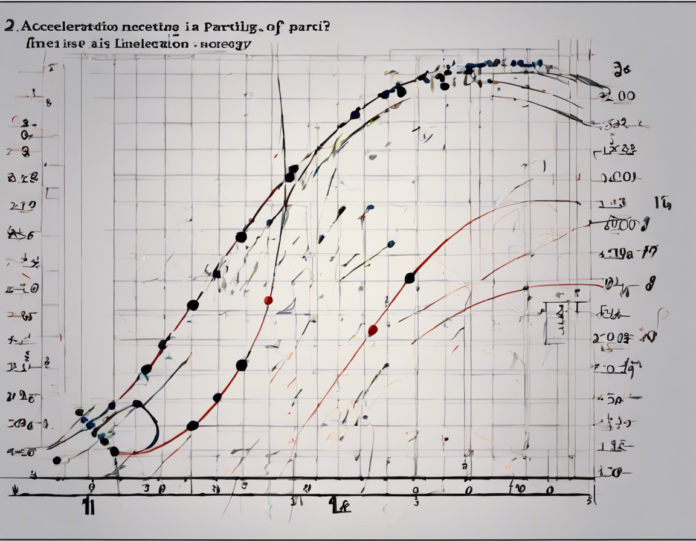Imagine a particle moving along a straight path, its acceleration causing its velocity to change gradually as time progresses. In this blog post, we will delve into linear acceleration, a fundamental concept in physics that describes how the velocity of an object changes at a constant rate over time. We will explore the underlying principles, equations, and real-world examples that demonstrate this phenomenon in action.
Understanding Linear Acceleration
Acceleration is defined as the rate of change of velocity with respect to time. When an object undergoes linear acceleration, its velocity increases or decreases by the same amount in each equal interval of time. In simpler terms, the velocity of the object changes by a fixed amount per unit of time.
Mathematically, linear acceleration can be expressed by the equation:
[ a = \frac{{\Delta v}}{{\Delta t}} ]
Where:
– ( a ) represents the acceleration of the object,
– ( \Delta v ) is the change in velocity, and
– ( \Delta t ) is the change in time.
The above equation indicates that the acceleration of an object is directly proportional to the change in its velocity over a given time interval. A positive acceleration implies an increase in velocity, while a negative acceleration (deceleration) denotes a decrease in velocity.
Equations of Motion with Linear Acceleration
To analyze the motion of an object experiencing linear acceleration, we can utilize the equations of motion derived from Newton’s laws of motion. For an object moving in a straight line with a constant acceleration ( a ), the following equations can be employed:
-
( v = u + at )
This equation relates the final velocity ( v ) of the object to its initial velocity ( u ), acceleration ( a ), and time ( t ). -
( s = ut + \frac{1}{2}at^2 )
Here, ( s ) represents the displacement of the object from its starting point after time ( t ). -
( v^2 = u^2 + 2as )
This equation connects the final velocity ( v ), initial velocity ( u ), acceleration ( a ), and displacement ( s ) of the object.
Example of Linear Acceleration
Let’s consider a car starting from rest and accelerating at a rate of ( 2 \, \text{m/s}^2 ). Using the equations of motion, we can determine various parameters of its motion:
-
If the car accelerates for ( 5 ) seconds, the final velocity can be calculated using ( v = u + at ):
[ v = 0 \, \text{m/s} + 2 \, \text{m/s}^2 \times 5 \, \text{s} = 10 \, \text{m/s} ] -
The distance traveled by the car during this acceleration period can be found using ( s = ut + \frac{1}{2}at^2 ):
[ s = 0 \times 5 + \frac{1}{2} \times 2 \times 5^2 = 25 \, \text{m} ] -
Utilizing the equation ( v^2 = u^2 + 2as ), we can verify the final velocity obtained:
[ 10^2 = 0 + 2 \times 2 \times 25 ]
This example illustrates how linear acceleration impacts the motion of an object, enabling us to predict its velocity and displacement over time.
Real-World Applications
Linear acceleration plays a crucial role in various real-world scenarios, ranging from transportation to sports and beyond:
-
Automotive Industry: Understanding the acceleration capabilities of vehicles is essential for designing efficient cars and ensuring safety on the roads.
-
Sports and Athletics: Athletes often focus on improving their acceleration to enhance performance in sprints, jumps, and other competitive events.
-
Space Exploration: Rockets and spacecraft rely on precise acceleration calculations to reach their intended destinations in outer space.
-
Mechanical Engineering: Linear acceleration is vital in the design and operation of machinery, robotics, and other mechanical systems.
By applying the principles of linear acceleration, scientists and engineers can address complex challenges and innovate across various fields.
Frequently Asked Questions (FAQs)
- What is the difference between acceleration and linear acceleration?
-
Acceleration refers to any change in an object’s velocity, whereas linear acceleration specifically denotes a constant rate of change in velocity over time along a straight path.
-
Can an object experience linear acceleration in the presence of external forces?
-
Yes, external forces can cause an object to undergo linear acceleration, resulting in changes to its velocity according to the applied force.
-
How does negative acceleration impact an object’s motion?
-
Negative acceleration, also known as deceleration, causes an object to slow down over time, leading to a decrease in its velocity.
-
Is linear acceleration always constant, or can it vary with time?
-
Linear acceleration typically remains constant over a specific period, but it can vary if the applied force changes during the motion of the object.
-
What are some common units used to measure acceleration?
- Acceleration is commonly measured in meters per second squared (m/s^2) or in terms of gravitational acceleration, denoted as “g” (approximately 9.81 m/s^2).
By exploring the concept of linear acceleration in-depth, we can appreciate its significance in predicting and analyzing the motion of objects in a wide range of scenarios. Whether studying the dynamics of a moving car or calculating the launch trajectory of a spacecraft, understanding linear acceleration is crucial for mastering the principles of classical mechanics and their practical applications.









